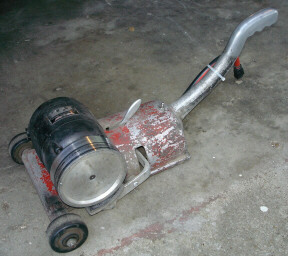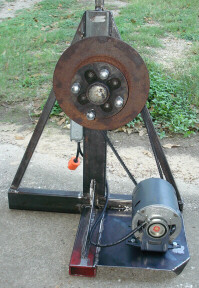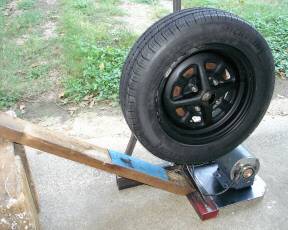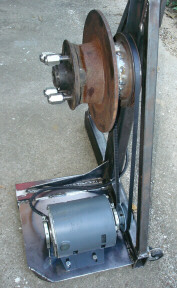
By Glenn Goodspeed (October 2008)
I think the balancing of automobile tires is generally a rip-off. To test this theory, I marked the locations and sizes of balancing weights on a freshly balanced wheel that was producing vibrations and took the wheel to a different shop and had it balanced again. The wheel came out of the second shop with different weights in different places, and it still vibrated at speed.
Modern tire balancing machines are capable of measuring out-of-balance conditions so small they require only a quarter-ounce of weight to fix. They can measure static and dynamic balance, and newer machines can even tell the operator how to reposition the tire on the rim to minimize any out-of-roundness in the tire and wheel.
But these machines have huge deficiencies: If a wheel is not mounted correctly in the balancer, if the technician does not know how to operate the machine, if the tire and wheel are too out-of-round to correct, or if the tire or wheel have invisible defects, a wheel balanced in the finest balancer will still vibrate on the car.
For years, the only tires that did not vibrate on cars I owned were the original tires that came with the car. Every time I put a new set of tires on a car, vibrations ensued at speeds above 60 mph. The first time this happened, I brought the car back to the tire shop. The tire technicians had many ideas about what might be causing the vibrations: shock absorbers, suspension bushings, alignment, brakes, bad wheels and on and on. I told them the vibrations began only after they put on the new tires, so they offered to rebalance the wheels. They did this, but the car still vibrated.
I decided I was wasting my time trying to get a solution from the tire shop and gave up. I'm sure this is what most people do if they are even aware of tire vibrations. I can't help observing vibrations in a car's tires, but most people either don't notice them or don't think they are important.
The few people who are aware of vibrations sometimes go to great lengths to find a solution. I read one man's story on the Internet. He bought a new pickup truck and it vibrated from day one. He brought it back to the dealership several times. The dealer supplied him with four new sets of tires and one replacement wheel, and still the problem persisted. It was only after he found a competent tire shop with a tire truing machine that the truck owner got a smooth ride.
I began to work on the balance question seriously a year ago. I acquired an old spin balancer at a swap meet and decided to put it to work. A spin balancer is simply a powerful electric motor with a drive hub. The motor is fastened to a small dolly that makes it easy to maneuver under a car. The balancer is capable of spinning a car wheel on the car at speeds approaching 90 mph. At this speed, balancing vibrations can be seen, heard and felt by an observant operator.

Spin Balancer
It took some time to teach myself how to balance wheels with the spin balancer. I found that I couldn't spin the rear wheels on my rear-drive car fast enough. I attributed this to the fact that on my car, spinning one rear wheel means you are also spinning the other wheel in the opposite direction, adding inertia and the resistance of the bearings and gears in the rear axle. So I moved the rear wheels to the front for balancing and put them back on the rear afterwards.
Spin balancing is simply trial-and-error. Start with no balancing weights and see how much vibration you get. Put a weight on (one ounce will do) and see if the vibration improves. Systematically move the weight to eight different positions on the wheel. Where you find the most improvement, try varying the amount of weight until you no longer detect any vibration. Mark the spot and remove the weight. Then divide the amount of weight in half and put half on the outside rim of the wheel and half on the inside rim in the same radial location.
Splitting the weight between the outside and inside of the wheel helps maintain dynamic balance. My experience indicates that static balance is much more important than dynamic balance. I might expect dynamic balance to be a factor on very wide rims, but on my 5-inch-wide rims, it does not have a noticeable effect. Nonetheless, it is a good idea to try to maintain dynamic balance.
I got all four wheels balanced perfectly with the spin balancer and took the car for a test drive. I still had vibration. I know this car very well, and I know that all the steering and suspension parts are in excellent condition. I replaced many of these parts when I was restoring the car. I measured the wheels and found them out of spec in radial and/or axial runout, so I replaced them. All that was left to investigate were the tires themselves.
The tires were new Michelin Harmonies. The size, 175/70-14, was recommended by Michelin for my 5x14" wheels. I began by spinning each wheel slowly by hand. Sighting across the tread of the tire, I could see it rising and falling slightly, indicating that the tire was not quite round. I wondered if a tool existed that could fix this, and some Internet searching turned up "tire truing" tools and "tire shaving" tools.
They seemed to be rare and expensive items designed for commercial shops, so I placed an ad on Craig's List to see if anyone had a used one for sale. The only person to reply wanted $1500 for a 20-year-old tire truing machine. I could not afford this, and even if I could, it would require an adapter for my wheels.
Most tire balancing machines have the same problem. They are designed to be used with cone-shaped fixtures that position the wheel by its center hole. My wheels have a center hole that is not designed to be used for this purpose, so an adapter with lug bolts is required to bolt the wheel to the balancing machine. Every tire shop worker has ignored this fact and attempted to balance my wheels using the center hole, proving that a balancing machine is only as good as its operator.
Even with the bolt-on adapter, the operator must be very careful to tighten the lug nuts gradually, constantly moving from one to another. If the nuts are not tightened evenly all around, the wheel can be fixed in a slightly off-center position. This is true when fastening the wheels to the car or any balancer or truing machine.
I called local tire shops and asked if they had a tire-truing machine. None did. I began to think about how I could do truing myself and came up with the simple idea of using a piece of coarse sandpaper tacked to a piece of two-by-four lumber. I set the rear axle on jack stands, started the car and put it in reverse gear. There were several problems with this method. The sandpaper stopped the wheel fairly quickly, as the differential diverted the power to the other rear wheel. The wheel was not turning very quickly to begin with. I was afraid that movement in the axle would cause the wheel to revolve slightly off-axis. It was awkward getting the two-by-four into position and holding it there. Worst of all, I was getting a carbon monoxide headache from spending so much time near the tailpipe.
The most valuable information I got from this experience was embodied in the thin layer of black dust that accumulated under the car. The concept was valid -- I had removed rubber from the surface of the tire.
I often design and build my own tools when needed, so I set about building a tire truing machine. I knew the sandpaper and two-by-four worked. The problem was getting the tire to rotate quickly, continuously and precisely, preferably without fumes and positioned so I could apply the sandpaper from the comfort of a chair.
I made some sketches and the machine evolved. I started by welding together a sturdy frame to minimize off-axis movement of the spinning tire. To hold the wheel securely and allow it to turn, I could think of nothing better than an original front stub axle, so I picked up a spare complete with the hub, bearings, lugs and brake rotor. I bolted the axle to the frame. I adapted a large crankshaft pulley from another car to serve as the driven pulley and welded it to the back of the brake rotor. To provide the motion, I added a 1/3 horsepower electric motor and fan belt.
I think it was at this point that the machine got part of its name from Dr. Frankenstein. The other part was supplied by my wife when she saw it in operation chewing up tires. The final version of the name is "Franken-Gator".



The Franken-Gator
So how well does it work? Pretty well! The motor turns at 1750 rpm. Given the sizes of the pulleys, the wheel turns at about 800 rpm. This is fast enough to give plenty of bite to the sandpaper, which is 40-grit silicon carbide designed for a belt sander. I found that the sandpaper lost some of its cutting power after doing one tire, so I repositioned it or changed it after each tire.
It takes about 45 minutes to true a tire. When starting, it's easy to tell how badly out of round the tire is. You can hear a distinct "ch-ch-ch" sound as the high spots hit the sandpaper, and you can feel the vibration in the two-by-four. I never got rid of these signs completely, but by the time I finished, the sound was much steadier and the vibrations weaker.
After truing, each tire must be balanced again. I did this using my spin balancer. Once I had all four wheels trued and balanced and back on the car, I went for a test drive. To my great satisfaction, the car was much smoother. At 60 mph, where the trouble used to begin, I could barely feel the rhythmic vibrations that signify tire problems. At 70 mph, the car was perfectly smooth. I think another round of truing and balancing would remove the vestiges felt at 60 mph, but the car is so much smoother now that I will rest on my self-conferred laurels for a while before giving it another shot.